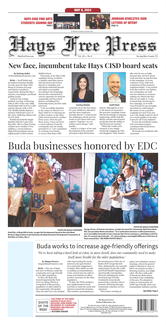This Week in Texas History
by BARTE HAILE
The attorney for a preacher accused of the shotgun slaying of the chief of police in Orange announced on June 11, 1935 that his client would plead temporary insanity.
The sensational murder case, which attracted nationwide press coverage, was moved to Houston on a change of venue. Rev. Edgar Eskridge was denied bail and held in the Harris County Jail until his day in court.
The trial began on June 1, 1936, a year and three days after the killing of Police Chief Ed J. O’Reilly. Eskridge was the life of the party waving at well-wishers and joking with reporters. He persuaded the Harris County health officer to pose for a picture and instructed photographers to “try to get him to put his stethoscope on my head. There is nothing there.”
Eskridge’s devil-may-care mood changed during three days of jury selection. By the time the twelfth seat was filled, he looked and acted like a man on trial for his life.
District Attorney Hollis Kinard summed up the state’s case in his opening remarks. Charging county and city officials with lax enforcement of the law, the pastor of the First Baptist Church armed himself to the teeth and went on an anti-crime crusade. When the chief of police took away his firearms, the defendant threatened to get even.
The first witness for the prosecution was the former mayor of Orange, who confirmed Rev. Eskridge declared war on the mayor, sheriff’s department and local police from his pulpit in February 1935. Then 10 days prior to the bloodshed, he publicly accused Chief O’Reilly of dereliction of duty.
County Attorney James Neff followed with his recollection of a meeting with the two antagonists the day before the murder. O’Reilly asked if Eskridge had any right to carry guns. Neff repeated the question, and the preacher produced an expired permit from an adjacent county.
“O’Reilly said something about filing charges, and the defendant agreed to pay a fine,” the county lawyer recounted. “However, we filed no charges.”
“Didn’t Eskridge threaten to call out Police Chief O’Reilly’s name and your name from the pulpit?” defense attorney Joshua J. Collins inquired on cross-examination. “He told the people I played poker,” Neff confirmed adding the disclosure did not bother him.
A former justice of the peace and the current mayor recalled an ominous comment from Eskridge later that same day. “They have dehorned me,” the agitated pastor proclaimed, “but they can’t take my buckshot away from me.”
Six eyewitnesses took turns reliving the shocking incident on May 29, 1935 in downtown Orange. The police chief was standing on a street corner chatting with a friend, when Rev. Eskridge drove up in his car. Without a word of warning, he stuck a shotgun out the passenger window and fired a fatal blast into O’Reilly’s head.
A candy store proprietor testified the victim appeared oblivious to the danger and never reached for his gun. “He was standing talking with his hands at his side.” The candy man recalled the reverend remarking a week or so earlier, “I’ve got the county officials going now, and I’ll have the mayor and city officials going too.”
Eskridge sped across the Sabine River into Louisiana, where he surrendered outside DeRidder. The prosecution put on display the arsenal removed from the getaway car by arresting officers – a .22 rifle, Smith & Wesson .38 special pistol, .45 Colt automatic and a shotgun with a sawed-off barrel. The widow of the murdered policeman wept uncontrollably at the sight of the murder weapon.
The defense spent 11 days trying to convince jurors Eskridge had not been in his right mind and may even have had reason to fear for his own life. Several members of the defendant’s congregation described his “peculiar actions,” which ran the gamut from rambling sermons full of violent denunciations to sudden outbursts of maniacal laughter.
The skeptical D.A. asked each churchgoer the same question: “So you went to town twice every Sunday to hear a crazy man preach?”
Four psychiatrists with identical diagnoses took the stand for the defense. As the result of manic depression and psychosis, Eskridge was temporarily insane at the time of the killing and unable to distinguish between right and wrong.
On rebuttal the prosecution countered with five shrinks of their own, who insisted Eskridge’s mind was as sound as the next man’s. The state also called 24 residents of Orange, many of whom belonged to the First Baptist Church, who swore the preacher appeared to have his wits about him in the months leading up to the murder.
The controversial case went to the jury on the afternoon of June 12. The courtroom had hardly cleared before the foreman notified the bailiff that a verdict had been reached.
The jurors rejected the temporary insanity excuse and found Rev. Edgar Eskridge guilty of murder without malice. But they came as close as the law allowed to cutting him loose by sentencing the cold-blooded killer to a token five years in prison.
Do you have your copy of “Tornadoes, Hurricanes & Other Disasters,” the latest “Best of This Week in Texas History” column collection? Order today at twith.com or mail a check for $14.20 to Bartee Haile, P.O. Box 152, Friendswood, TX 77549.




